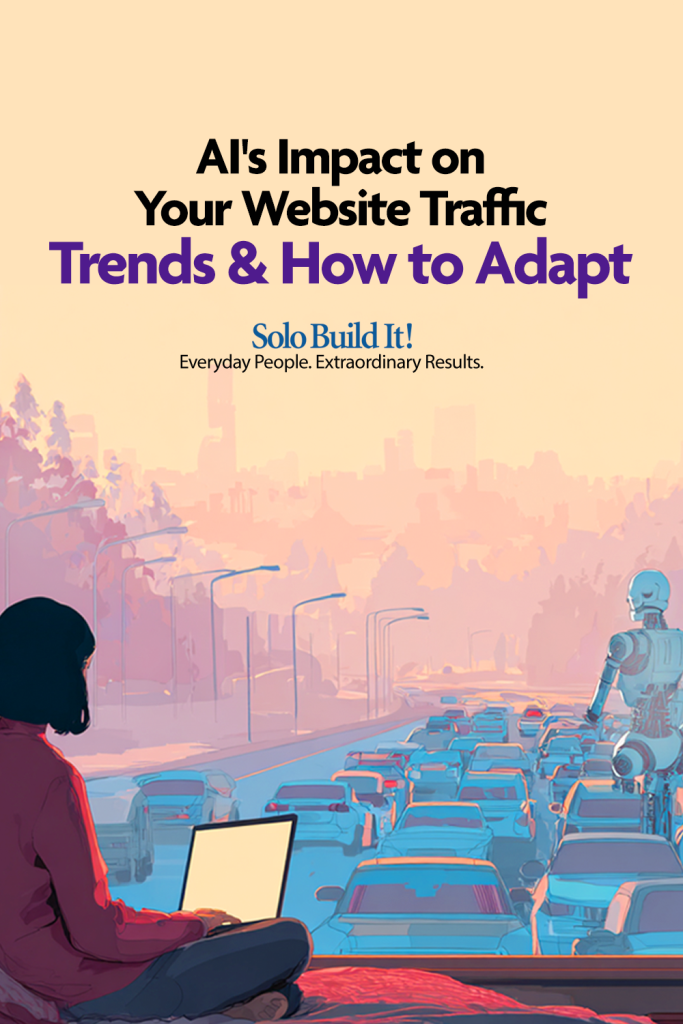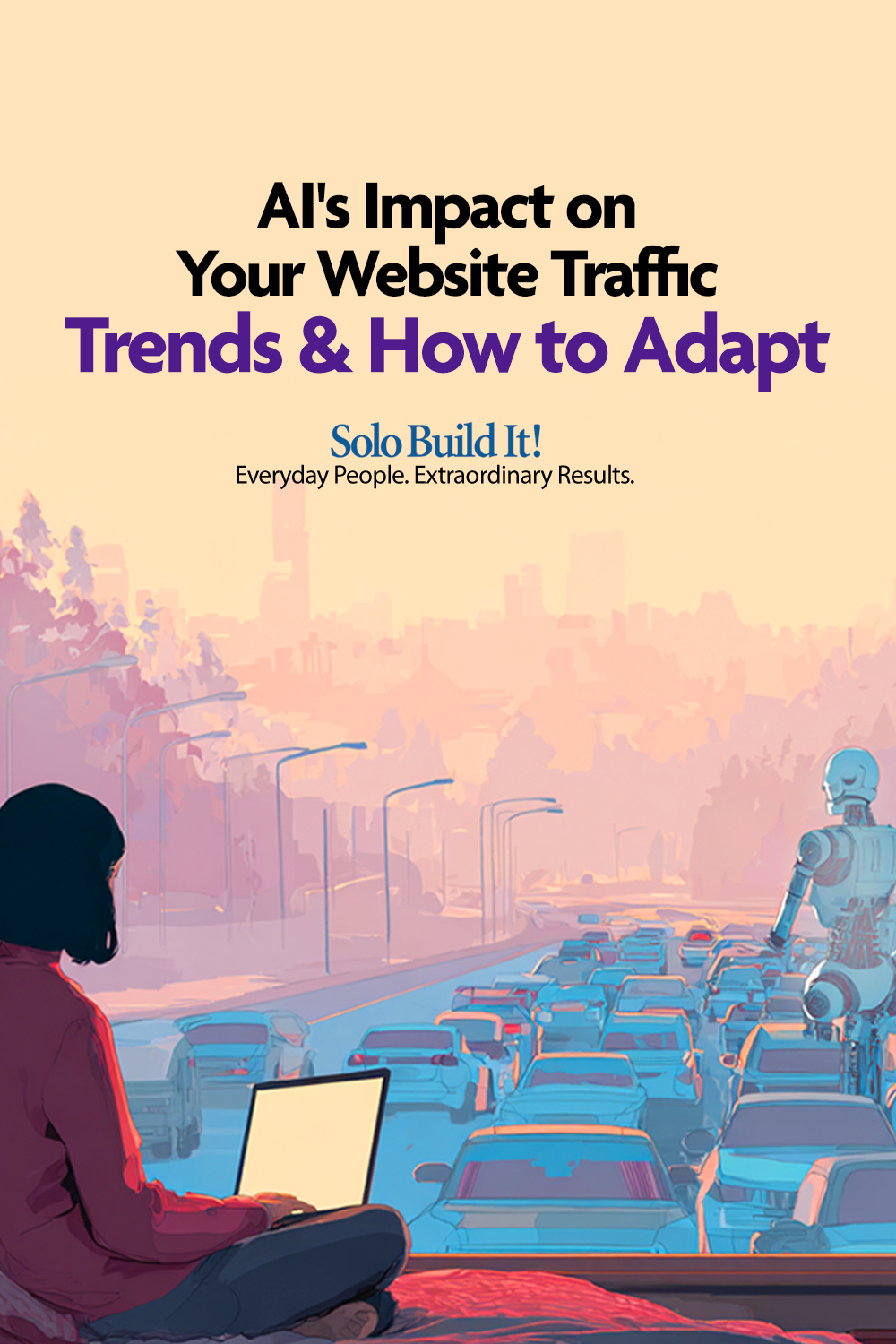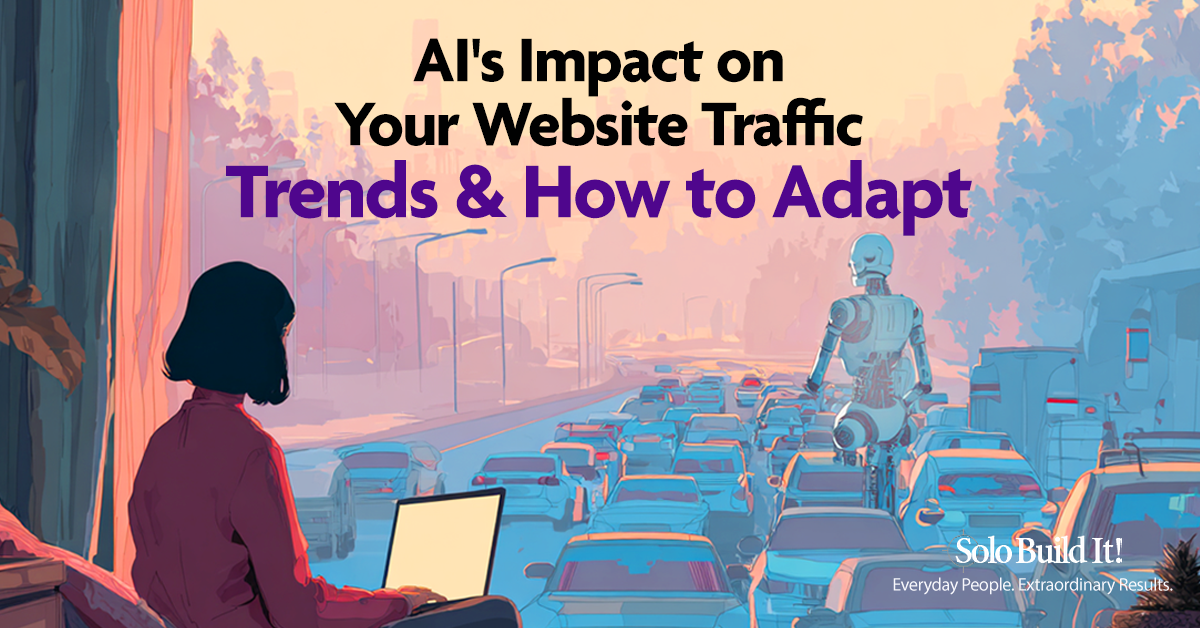In our previous exploration of “The Future of Search,” we established why chasing fleeting AI optimization “tricks” is a waste of time. The real key, as always, lies in creating outstanding, user-focused content.
But a crucial question remains: as AI Features like Google’s AI Overviews and standalone AI Products like ChatGPT become more prevalent, what will their actual impact be on your website’s traffic and income? Let’s dive deeper into these specifics.
The Rise of AI Features: Will Google’s AI Overviews Help or Hurt Your Site?
We’ve previously discussed why AI Features (AIFs) like Google’s AI Overviews aren’t yet a primary traffic driver. But what happens when they are fully adopted?
One concern is clear: if AI Overviews perfectly satisfies a user’s search, they might not click through to your website, even if you previously received visitors for that query. This could directly impact your income.
It’s Not a Zero-Sum Game
But does this mean an inevitable drop in traffic? Not necessarily. The “zero-sum game” assumption – where total search volume remains static – might be flawed.
In reality, total search volume tends to increase. Consider two factors:
“AI Growth”: AI can introduce entirely new types of search queries (questions not typically asked of Google) and generate significant publicity, boosting overall search activity.
“Normal Growth”: Separately, Google’s own search volume has been growing by roughly 10% annually since 2020.
For discussion’s sake, let’s say “AI growth” adds 20% to search usage, and “normal growth” contributes its usual 10%. This totals 30% overall growth. In such a scenario, even if “regular search” lost 23% of its share within that expanded total, overall traffic (and therefore potential income) could remain stable compared to the previous year, perhaps even gaining some bonus clicks from AI Overviews.
Short vs. Long Keywords: Who Will “Switch” to AI Answers?
Another way of looking at this…
What percentage of searchers are likely to “switch” from search to AIF? Short keyword terms are likely to remain as search. However, if you’re already planning to use 4, 5 or more words in your search, you’re already getting close to asking a question, so it’s a short hop to reading an AI Overview.
We need a few stats before we can estimate the AIF impact…
People use 1-, 2- and 3-word keywords for 21.7%, 24.0%, and 19.6% , respectively, of all searches (according to a Wordstream study). It’s reasonable to assume that these people will keep using regular search for straightforward keywords because the nature of the query is so different from a sentence or question in an AI prompt. Adding those values, it means that 65.3% of searches could remain unchanged.
The distribution drops off rapidly after that for long-tail keywords:
- 4-word keywords: 10-15%
- 5-word keywords: 5-10%
- 6-word keywords: 2-5%
Backlinko found that the total of all long-tail keywords only amounts to 3.3% of the total search volume. Compared to the 22.5% average in the Wordstream study, that’s quite a difference.
Let’s take a conservative middle ground and estimate that long-tail keywords, ripe for becoming AI questions, account for roughly 13% of search.
The Current Picture: AI Overviews Adoption and “Low Impact” Theory
Considering these factors, the immediate impact of AIFs like AI Overviews on your overall traffic volume might be less dramatic than feared. If a large portion of searches (short keywords) are less likely to shift, and only a smaller segment (long-tail) readily translates to AI questions, the overall traffic displacement could be moderate.
At the time of my research for “Make Your Site Win (Again),” AI Overviews appeared in just over 30% of search results, according to Advanced Web Ranking’s tracking tool.
While the AWR tool now indicates a figure closer to 50%, broader industry studies from early 2025 by sources such as Semrush and Conductor reported AI Overviews appearance rates for all U.S. desktop queries in the range of 13-14%.
Why these differences? It’s likely that the studies use different ways of measuring or look at different sets of keywords. What’s clear, though, is that even with these numbers changing and AI Overviews appearing more often, many searches still don’t show them.
When we combine this perspective with our earlier discussion about potential overall search growth, it stands to reason that the initial impact of AI Features on smaller sites may not be as severe as some predict.
However, let’s not ignore potential downsides.
What’s the Worst-Case Scenario?
Google claims AI Overviews actually increases clicks to websites compared to traditional listings, stating:
“AI Overviews gets more clicks than if the page had appeared as a traditional web listing for that query.”
The SEO community remains skeptical, awaiting supporting data (Tick tock, tick tock…). While it’s good Google acknowledges the concern, let’s consider why AI Features (AIFs) might still lead to fewer clicks for your site:
Instant Gratification: If AI Overviews perfectly answers a user’s query, they may feel no need to click further, reducing visits to underlying websites.
Visual Dominance: AIFs often occupy significant screen space. This can push the traditional “10 blue links” further down, making them less visible and less likely to be clicked. (Though, as noted, the space AIFs take up has been adjusted over time.)
The Long Game for AI: As AIFs improve, they could theoretically satisfy so many queries directly that traditional search listings become less relevant over time.
While that last point is a more distant possibility, these are valid concerns. We’ll touch on the separate impact of standalone AI Products (AIPs) like ChatGPT or Gemini in the next section, but for now, their direct impact on your existing search traffic is minimal, potentially even offering bonus opportunities.
Despite these potential downsides of AI Features like Google’s AI Overviews, I ultimately believe that small sites producing high-quality, winning content should fare well, perhaps even better, in the long run.
AI Product (Standalone Answer Engines): A Different Kind of Impact?
Now, let’s shift our focus to standalone AI Products (AIPs)—think dedicated platforms like ChatGPT, Gemini (at gemini.google.com), and Claude. Could their impact on your website actually be positive?
It’s an interesting question, especially when you consider their current accessibility. You won’t find direct links to gemini.google.com from the Google homepage or its search results, not even within an AI Overview.
To use these AIPs, people generally need to know they exist and navigate to them directly. This means they haven’t yet fully “crossed the chasm” into mainstream, everyday use for the average internet user.
So, for now, don’t worry about the standalone answer engines. In fact, they might even refer additional visitors to your site or blog.
How Could Standalone Answer Engines Be “Net Positive”?
In time, we’ll learn to ask these standalone engines a ton of questions, seek explanations, etc. This is information that we need/want to know every day. Most people, however, have not trained themselves to ask them yet.
For example, I probably ask questions of ChatGPT, Gemini or Claude 15 to 20 times per day. It could be for something as simple as wanting to know which day of the year gets the most hurricanes. That said, I still need to remind myself… “hey, Self, ask Claude.”
How many times have you used one of the AI products to find out more about something that I wrote? I’ll bet there are still many of you who are answering, “None.”
Like I said, old habits are hard to change if the experience they deliver is still fine.
There are gazillions of questions for which we could be using these AI products, questions that don’t get a good response from search (e.g., asking for a step-by-step process for making marmalade, summarizing a document, explaining “crossing the chasm” with follow-up questions, etc.).
The Future Trajectory: AIP Adoption and Integration

When Google is finally satisfied with its testing, expect it to fully integrate its AI offerings —perhaps by making Gemini more prominent on its homepage or expanding AI Overviews usage.
Earlier, I estimated that perhaps only 15% of what we currently consider “regular searches” might eventually “switch” to being directly posed to standalone answer engines.
Given the simultaneous growth in overall search and the rise of new query types suited for AIPs, this potential shift in existing habits is unlikely to feel like a significant drop. Instead, as more people discover the unique benefits of direct AIP interaction for complex tasks or exploratory questions, these platforms represent a growing source of bonus traffic potential.
So, expect standalone answer engines to become steadily more popular. This adoption might take longer than expected, but it’s a clear trend. Better results drive more usage, and more usage (and user feedback) drives better results—a classic positive feedback loop.
Beyond search itself, this technology will be integrated into all kinds of other products (e.g., your smartphone’s AI personal assistant). Some will have a results page with links (e.g., personal assistant queries), others may not.
In time, I do expect LLMs to pay the sources of their content (i.e., you!), including large, aggregated groups of smaller sites. As these standalone answer engines become widely, even wildly, popular, the mechanisms for this “payback” could mean more income for you, the content creator.
It’s a “Field of Dreams” scenario: if you build excellent, helpful content, the audience (and the opportunities) will come.
SearchGPT: A Glimmer of Hope for Content Creators?
OpenAI’s SearchGPT is a prototype search engine, designed to leverage the power of AI for enhanced search capabilities.
This search engine combines the strengths of OpenAI’s GPT-4 models with real-time information from the web, aiming to provide users with fast and accurate answers accompanied by clear and relevant source links.
Why SearchGPT Is Intriguing for Searchers, And Even Better for Marketers
This prototype is particularly noteworthy because it aims to respect and support publishers by prominently citing sources and offering ways for them to manage how their content appears in the search results.
This gives what I foresee as an opportunity to an entrepreneur who aggregates and represents millions of smaller sites. If AI Overviews and Copilot had not yet recognized the wisdom of paying high-quality sites, it could cause sites to insert a bit of code onto every web page, telling Google’s and Microsoft’s AI to stay away, putting them at a huge data disadvantage.
A rapid, viral spread by such a standalone answer engine could be a favorable development with mid- and long-term financial benefits, all while the short-term impact is negligible.
An In-Depth Look at SearchGPT
It’s a beta release that went into testing with 10,000 users at launch.
What’s the difference between this and regular search? It delivers a summary of web pages that rank highest for a keyword search, rather than just presenting 10BLs.
You can ask follow-up questions.
It prominently cites its sources, with clear, inline links that lets visitors know where the info came from. Visitors can click to read more from sources.
It provides even more results in a sidebar with source links.
Is SearchGPT in Direct Competition to Perplexity?
Both SearchGPT and Perplexity function similarly. Unlike Perplexity though, which has had legal problems with publishers, OpenAI’s SearchGPT was developed in collaboration with various news partners (e.g., Wall Street Journal, Associated Press, etc.).
Publishers can manage how they appear in search features. They can even opt out of their content being used and still be surfaced in search.
What has OpenAI not told us? How it plans to monetize!
It’s spending billions of dollars to develop SearchGPT. It has massive ongoing expenses for compute time, electricity (a massive expense), ongoing hardware requirements, bandwidth, etc.
It needs to figure out monetization quickly. It’s fair to say that content websites are unlikely to be paid until AI-based search products figure out how to pay themselves. And that’s OK because we’d only be “losing” income that did not exist yet! Once the ads start scaling, though, I’d expect high-ranking sites to generate income with SearchGPT.
How SearchGPT Could Reshape Creator Compensation
Let’s restate this, as it’s a crucial point: SearchGPT, if its publisher-friendly model becomes influential, offers strong positives for content creators.
By emphasizing source citation and providing additional links, it presents a model where income lost from shifts in “regular” search could potentially be offset, or even exceeded, especially if competitive pressure encourages other AI platforms to adopt similar practices.
A Fundamental Difference: SearchGPT vs. Traditional LLM Behavior
It’s also important to understand a key difference here. Traditional Large Language Models (LLMs) like Gemini, ChatGPT, and Claude synthesize answers from their vast internal knowledge base (much the same way that we all do). The LLM has no idea where the info came from.
SearchGPT, on the other hand, acts more like an enhanced search engine. It “reads” relevant web pages in response to a query, then organizes and summarizes that content for easy consumption. This inherent connection to source material is why it’s providing more citations.
The Path to “Enlightenment”: Why AI Engines Need to Value Small Creators
Because SearchGPT works differently and could create competition, other AI tools might also start to better recognize and reward smaller sites for their quality content.
The bottom line is this: while a decrease in “regular” Google search traffic initially impacts income for niche websites, this pressure could be counteracted if…
- Publisher-centric models like SearchGPT gain traction and influence other Standalone Answer Engines, or
- The major AI players reach a state of “enlightenment.”
What do I mean by “enlightened?” It’s the realization that the long-term health and richness of the web—and therefore their own AI products which rely on that web content—depends on the survival and thriving of millions of smaller, independent content creators.
Between this potential for competitive pressure and the fundamental need to treat smaller sites as partners (much like they already do with major publishers), I believe the mid- to long-term future for small sites producing quality content is excellent.
So, What’s the Real Deal with AI and Your Site? (And What To Do Now)
We’ve looked at AI Features like Google’s AI Overviews and standalone AI Products like ChatGPT, Gemini and Claude. The truth is, while they’re definitely changing things, their direct impact on your traffic right now might not be as significant as some folks make it out to be.
Overall search is growing, and many people aren’t using these AI tools for every little thing just yet.
Plus, the good news is that these AI tools are getting better at giving credit (that means links!) where it’s due. That’s a win for those of us creating great, original stuff.
If your traffic has taken a nosedive lately, chances are it’s less about AI Overviews stealing your clicks and much more about Google’s regular algorithm updates, like the Helpful Content Update (HCU). That’s what’s shaking things up for most websites right now.
So, while it’s smart to keep an eye on how AI is changing search for the long haul, your immediate focus needs to be on fixing what’s likely hurting you today.
And that’s exactly what Part 2 of my book, “Make Your Site Win (Again),” is all about. It’s a step-by-step Traffic Recovery Program. No fluff, no chasing AI fads. Just a solid plan to get your content back in shape, making it the kind of stuff users love and Google wants to rank.
The full “Traffic Recovery Program” is waiting for you inside Solo Build It! (SBI!). It’s all part of the deal—the book, the tools, the know-how, the community—everything you need to get your site winning again, no matter what Google or AI throws your way.
Stay on top of AI developments and how they impact you as a blogger or online business owner. Subscribe to our free newsletter, and never miss a new article.
Subscribe For Free
Read Other Articles in This Series:
Ken Evoy Releases New Book to Help Website Owners Recover from Google Updates
Beyond the Helpful Content Update: The Real Lessons Google is Teaching Us About the Future of Search
Large Language Models: What Content Creators Need to Know
Understanding the 3 Phases of Search: A Guide for Website Owners
The Future of Search: Why Obsessing Over AI Optimization Misses the Point





